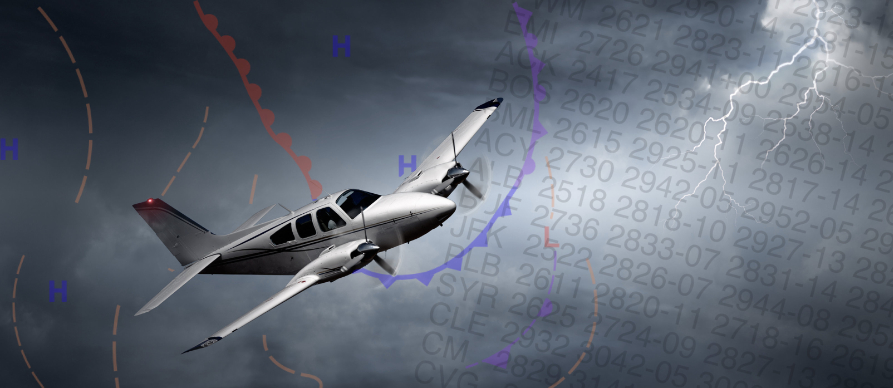
It is essential that pilots understand how to acquire and interpret various weather products, charts and briefings.
The Flight Service Station (FSS) is the primary source for preflight weather information.
A preflight weather briefing from an FSS can be obtained 24 hours a day by calling 1-800-WX BRIEF from
anywhere in the United States. Telephone numbers for FSS can be found in the Chart Supplement
U.S. (or in the United States Government section of the telephone book. The FSS also provides in-flight weather briefing services and weather advisories to flights within the FSS area of responsibility.
Prior to any flight, pilots should always be in receipt of a recent weather briefing (especially cross country flights)
There are three different types of briefing a pilot can request.
- Standard Briefing This type of briefing contains the most complete weather picture and should be obtained prior to any flight. Contents of this briefing include: adverse conditions, VFR flight recommendation, synopsis, current conditions, en-route forecasts, destination forecasts, NOTAMS, winds and temps aloft, and more.
- Abbreviated Briefing. This briefing is a shortened version of the Standard Briefing. It should be used to supplement a Standard Briefing after a delayed departure time.
- Outlook Briefing This type of briefing is a future forecast briefing. It does not give current weather conditions and should only be requested when the planned departure time is more that 6 hours in the future.
So that your briefing can be tailored to your needs, provide the briefer with the following information about your flight
- Your qualifications (e.g. student pilot),
- The type of flight planned (VFR),
- The aircraft’s N-number e.g N267ND
- The aircraft type, (e.g PA28)
- Departure point, (Airport Code and name – e.g KBED for Hanscom)
- Estimated time of departure, (UTC / Zulu time – calculate before calling!!)
- Proposed flight altitude(s), (e.g 3,500 feet)
- Proposed route-of-flight, if other than direct; specify any planned landing point en route,
- Destination, (Airport e.g KASH for Nashua)
- Estimated time en route. (e.g 60 mins / 90 minutes etc)
Ask the briefer to provide a standard briefing. This briefing will follow specific procedures and use standard phraseology developed by FAA flight services personnel.
The briefer will first advise you of any adverse conditions along your proposed route of flight.
When a VFR flight is proposed, and actual or forecast conditions make VFR flight questionable, the briefer will describe the conditions and may advise you that “VFR flight (is) not recommended.” If this occurs you are still entitled to a complete briefing; however, if you feel that the weather conditions are beyond your capabilities (or that of your aircraft or equipment), you should consider terminating the briefing (and your flight). This will free the briefer to handle other incoming calls.
Just because the briefer does not issue this statement does not necessarily guarantee a flight free from adverse weather effects. Phenomena such as thunderstorms, turbulence, mountain obscurations, and strong winds do not, in and of themselves, warrant this statement.
Only you as pilot in command know your own capabilities and limitations.
Briefers will typically summarize weather reports and forecasts, unless you specifically request that
they be read verbatim. Try not to interrupt the briefer unless the briefer is speaking too fast. At the conclusion of the briefing ask for any additional information you may require, or for clarification of any point you do not completely understand. The amount of detail in your weather briefing will depend upon the complexity of the weather situation .
It is both your responsibility and prerogative as a pilot to obtain a standard briefing
For more information view
Official Weather Sources
AviationWeather.gov is a website provided by the Aviation Weather Center (AWC), which is a part of the National Weather Service (NWS) under the National Oceanic and Atmospheric Administration (NOAA).
The site is dedicated to providing meteorological information specifically tailored for the aviation industry.
It offers a wide range of weather products and services that are essential for safe and efficient flight operations.
The site is considered to be an official source of weather information and a vital resource for pilots, who need accurate and timely weather information to ensure flight safety and efficiency.
Key features of AviationWeather.gov include:
- Weather Maps and Charts: These include surface analysis maps, radar, satellite imagery, and upper-air charts.
- Forecasts: Terminal Aerodrome Forecasts (TAFs), Area Forecasts, and SIGMETs / AIRMETs for en route weather conditions.
- Current Conditions: METARs (Meteorological Aerodrome Reports), pilot reports (PIREPs), and real-time weather observations.
- Advisories and Warnings: Information on turbulence, icing, and convective weather advisories.
- Tools and Resources: Tools for planning flights, such as flight path forecasts and aviation weather graphics.